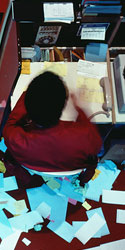We asked a number of professional organizers to be part of a three question interview. This is the first of those questions that we will be publishing over the next few weeks. Thank you to everyone who participated and shared their perspective.
What is the single most important tip you would give to someone who is having trouble managing all the paper in their lives?
“Recycle most of it as soon as it comes in the door.”
Melissa Michaels from The Inspired Room (rss)
My trash can is right next to the mailbox. I’ve found that I can often get by without even bringing junk mail into the house. I’ve heard other people recommend that you open your mail over the trash can or recycle bin to help make it easier to throw things away by making it the default behavior.
Stop doing everything you are doing at the moment of complete mental breakdown. Take a large breath, put on some fun music and start sorting. Pile every single paper in one spot, grab the nearest empty trash can and sort into three sections: TRASH, PROJECTS, TO FILE. Trash goes into the trash can, your To File pages go into a designated area and your Projects or To Do’s sit nicely next to wherever you are going to work on them at. Once the chaos is gone, it will be a lot easier to implement a system that is customized to your organizing style: Inspirational, Logical, or Visual.
Suzanne Babb from Let’s Talk Organizing (rss)
Good point. I think a lot of people keep trying to plug away operating an very low efficiency because of their mental and physical disorganization.
Keep as little paper as possible in the first place by setting up an effective system for the complete lifecycle of your paper. I also have a Paper Retention Guide which advises on what papers to keep and for how long in a very easy to read and reference chart format. All of my guides can be accessed at www.neatandsimpleguides.com
Ariane Benefit, M.S.Ed. from Neat and Simple Living (rss)
When I’m working with clients on technology needs, I encourage them to think about the the entire lifecycle of the technology they purchase. For example, when they create a plan to buy a computer, they should also create a plan for how they are going to replace and dispose of it in the future. Ariane’s suggestion is to do the same thing for paper and think in terms of how the paper comes in, what happens to it and when it eventually goes out. When you think in these terms it is much easier to design your system effectively because it maps to your plan.
Ask yourself “Do I really need this?” before hitting the “print” button or bringing flyers or other printed information back to your home or office.
Janet Barclay from From the Desk of Janet Barclay (rss)
Something that I use with businesses that are trying to lower printing costs is to make it “hard” to print. For example, putting a shared high speed printer in the workroom instead of giving everyone their own inkjet printer reduces printing cost by being more efficient and because people are less likely to print something they don’t need if they have to go into the other room to get it.
Have less of it. Be ruthless and selective about the paper you bring into your life, whether it’s mail, free publications or otherwise. That might sound like a generalization, but having less paper means less time managing it.
Brandie Kajino from The Home Office Organizer (rss)
This is a very important point for paperless systems as well. Just because it is easy to scan something doesn’t mean you should keep it. I think it is easier to manage the scanned documents than the paper ones–at least it scales much easier. But at the same time, it is easier to manage 1,000 digital documents than 100,000.
Limiting free publications is pretty important too. There are a number of magazines available that don’t actually charge any type of subscription fee. They want as much distribution as possible because they make money of advertising. While these can be good sources of information, it is easy to start collecting more subscriptions than you can possibly read. I have recently started switching to short newsletters for my reading. They are typically much more expensive, but the information is much more concise and focused.

Thanks for including me in this great group! I also love your notes in between. I especially like your comment about making it “harder” to print. Nothing makes you think twice like having to interrupt what you’re doing!
@Brandie – Thanks for taking the time to participate. I appreciated having your point of view to add to the discussion.
Hi Mark!
Thanks for including me! I left a follow up comment here a few days ago but it’s not here. Did you receive it?
Thanks again for all the great tips. I love your group interviews!
Ariane
Hey, thanks from me too! I love all the great tips you share here!
Melissa
I’ve found CatalogChoice to be pretty helpful in limiting the number of paper catalogs and publications I receive…
http://www.catalogchoice.org/